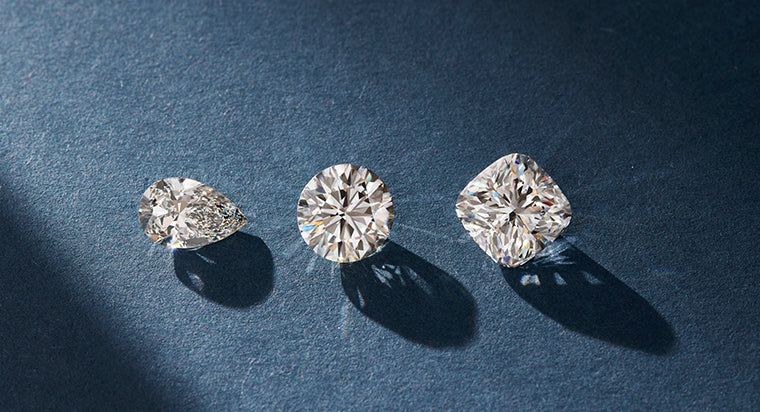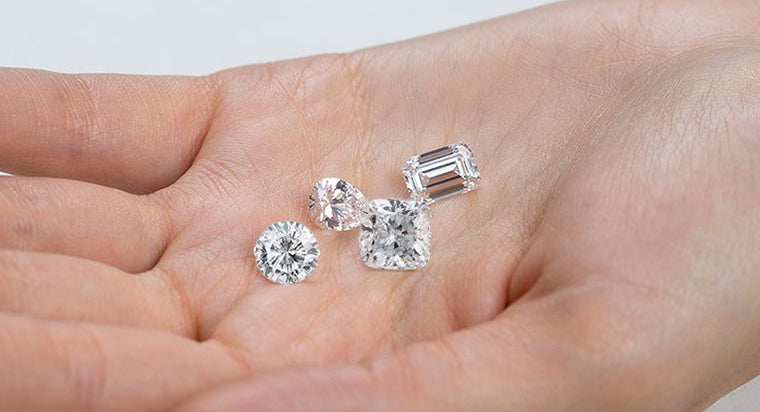Everything About Diamond Cuts

Technology changes impact every area of life, and that includes diamond cutting as well. Diamond-cutting tools and techniques have evolved since the early point diamonds were cut thousands of years ago.
Diamonds look exquisite, but well-cut diamonds look even more stunning. Diamond cutting is crucial because it influences the diamond's brilliance, fire, and overall appearance. The quality of the cut determines how well a diamond reflects light, which enhances its sparkle and makes it more visually appealing. A well-cut diamond maximizes its inherent beauty and value, regardless of shape or size. Precision in diamond cutting also ensures that the facets are symmetrically aligned. This contributes to the diamond's symmetry and proportion, impacting the stone's overall aesthetic. The diamond-cutting process is essential not only for enhancing a diamond's appearance but also for optimizing its market value.
TABLE OF CONTENTS
Early History of Diamond Cutting
Diamonds were first discovered over 2,000 years ago and played a very prominent role in the trade and culture of ancient civilizations.
Ancient civilizations didn't have access to the diamond-cutting tools and techniques that are used today, so diamonds looked a little rougher. One of the earliest methods was the point cut, and we'll cover early diamond-cutting techniques so you can see how the process has improved over time.
The Evolution of Cutting Techniques
Early diamond cuttings started with point cut and then evolved into the table cut, old single cut, rose cut, and eventually, the brilliant cut.
Point Cut (14th Century)
The earliest known style of diamond cutting is the point cut, which retained the natural octahedral shape of the diamond crystal. Minimal cutting and polishing were done to enhance the diamond's natural facets, so this diamond didn't have facets to enhance the diamond's brilliance.
Table Cut (15th Century)
As tools and techniques improved, the table cut emerged. This cut involved grinding down the top of the diamond to create a flat surface (the table) and adding a few other facets to enhance the diamond's ability to reflect light. The table and facets helped table-cut diamonds have more reflective properties.
Old Single Cut (16th Century)
The Old Single Cut, which emerged in the 16th century, is one of the earliest forms of diamond cutting that sought to enhance the diamond's natural sparkle. This cut features a simple and symmetrical design with typically 17 to 18 facets, including a large table facet on top, a small culet on the bottom, eight bezel facets on the crown, and eight pavilion facets.
The Old Single Cut is less complex than modern cuts but was a significant advancement for its time, allowing for greater brilliance and light reflection compared to previous methods. Cutters used a bow drill to achieve this cut, which was a simple rotating tool operated by a cord or bowing motion. They used techniques like cleaving, pointing, bruting, and polishing to get the diamond cut the way they wanted.
Rose Cut (17th Century)
The rose cut became popular during the Renaissance and in Europe. It features a flat bottom and a domed top with triangular facets arranged symmetrically. An interesting fact about rose cuts is that the cut was aimed to maximize the diamond's sparkle in candlelight, which was the primary source of illumination at the time.
Brilliant Cut (17th-18th Century)
The Brilliant Cut, developed in the late 17th to early 18th century, was designed to maximize a diamond's brilliance and fire by optimizing the way light enters and reflects within the stone. This cut featured a round shape with 58 facets: 33 on the crown (the top part of the diamond) and 25 on the pavilion (the bottom part).
It's said that Venetian diamond cutters were among the first to experiment with this cut, which was later refined by Flemish and French cutters in the 18th century. This cut laid the foundation for the modern round brilliant cut, which is still one of the most popular diamond cuts.
Modern Diamond Cutting Techniques
Past diamond-cutting techniques set the stage for modern diamond-cutting methods, such as the old mine cut and modern round brilliant.
Old Mine Cut (19th Century)
The Old Mine Cut, popular in the 19th century, is a precursor to the modern cushion cut. It features a square or slightly rectangular shape with rounded corners, a high crown, a small table, and a large culet (the bottom facet).
This cut is characterized by larger facets and a deeper pavilion compared to modern diamond cuts, giving it a distinct, romantic appearance with a subtle play of light and dark areas. This cut was handcrafted, so each diamond's faceting arrangement and proportions were unique, adding to its charm.
Transition to Modern Round Brilliant (Early 20th Century)
Marcel Tolkowsky published his thesis "Diamond Design: A Study of the Reflection and Refraction of Light in Diamond." In it, he discussed his formula for the ideal proportions of the round brilliant cut in 1919 to maximize the diamond's brilliance and fire. His formula suggested specific proportions for the diamond's depth, table diameter, crown height, pavilion depth, pavilion angle, and crown angle. These proportions were based on his calculations of how light interacts with a diamond, aiming to achieve the optimal balance between the diamond's ability to reflect and refract light, thus maximizing its beauty. Tolkowsky's work laid the foundation for modern diamond-cutting principles to maximize brilliance and fire.
Technological Advancements
In addition to techniques, technological advancements continue to change diamond cutting as well. Laser cutting improves diamond cutting by allowing for more precise and intricate cuts, reducing waste, and enabling the cutting of diamonds that would be challenging or unattainable to cut with traditional methods.
Specialty and Fancy Cuts
The evolution of diamond cutting has allowed more intricate and unique diamond shapes, such as emerald, princess, heart, and pear diamonds. While round and princess-cut diamonds remain popular, other cuts, such as oval and pear, are gaining popularity. You can check out the With Clarity website, look at different diamond cuts, and choose the one that best suits your dreams.
Ethical and Environmental Considerations
More efficient diamond-cutting processes mean that more of the rough diamond can be used, and there's less waste. Whether natural or lab-grown diamonds, less waste is better for the environment. Ethically sourced diamonds and materials are also more important to modern couples as they are more environmentally conscious. Advancements in technology will continue to improve the efficiency of diamond cutting and ensure there's less waste.
Conclusion
Diamond cutting has come a long way since the early point cuts of the 14th century. Today's diamond rings are precise and look spectacular. The evolution of diamond cutting improved facets as well as the reflection of light and the value of each diamond. Each step in the diamond-cutting evolution improved the process and enhanced the diamond's qualities. Technology will continue to refine the diamond-cutting process.









